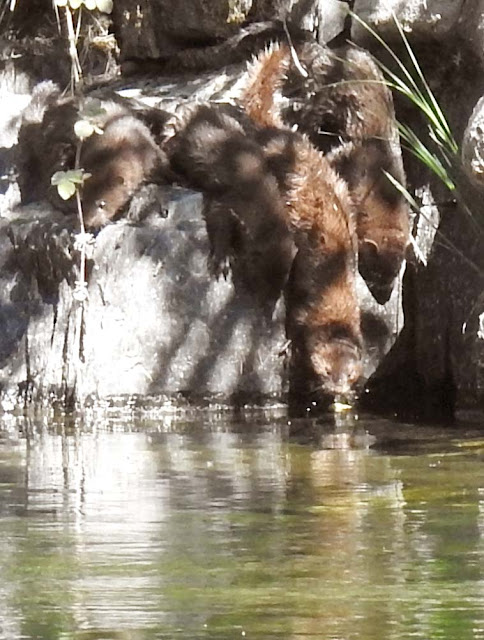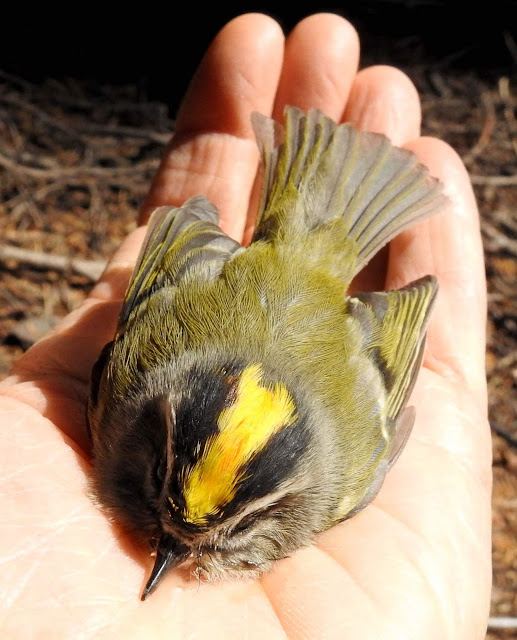River Sparkles
Almost every day I watch the river from our local bridge. I never know what I might see. It's always changing! It's pretty low, slow, and cold right now. One late afternoon a section of the river was covered in fine sparkles that looked like glitter! I climbed down to check out what was refracting the light and found several hundred water striders cruising around on the river's surface!
Water Striders - Gerridae
The following information is from en.Wikipedia.org.
"Gerrids that live in environments with winters will overwinter in the adult stage. This is due to the large energy cost which would need to be spent to maintain their body temperature at functional levels. These water striders have been found in leaf litter or under stationary shelters such as logs and rocks during the winter in seasonal areas. This reproductive diapause is a result of shortening day lengths during larval development and seasonal variation in lipid levels.
Shorter day length signals the water strider of the coming temperature drops, also acting as a physical signal the body uses to store lipids throughout the body as food sources. Water striders use these lipids to metabolize during their hibernation. The length of the hibernation depends when the environment warms and the days become longer again. they often live in large groups. These large groups usually form during the non-mating season since there is less need to compete. Instead of competing to reproduce, water striders can work together to obtain nutrition and shelter outside of the mating season. Water striders will attempt to disperse when these groups become too dense. They do so by flying away or cannibalizing."

Red-shouldered Hawk - Buteo lineatus
One morning as I approached the bridge, there were two Common Ravens on the road. They took off when they saw me and landed on the bridge railing. A few seconds later another large bird followed them and landed a few feet from them. To my total surprise it was a Red-shouldered Hawk! The three of them then flew off down the river together! How unusual!
I've only seen one Red-shouldered Hawk in our area before. Typically they live in lower elevations, but have increased their range up into our area. Riparian areas are their preferred habitat. Red-shouldered Hawks eat reptiles, amphibians, small mammals, and occasionally birds, such as Mourning Doves, House Sparrows, and Starlings. Common Ravens are not in their diet, thank goodness!

Belted Kingfisher (female - male) - Megaceryle alcyon
Kingfishers live here year-round. I have seen a female frequently, but just this week I spotted a male! The female is the one with the rusty-brown chest band. Males and females stay together to mate and raise their young, from April to August. The rest of the year they live independently. These birds dive into the river to catch small fish, crayfish, frogs, and tadpoles. I love hearing their loud rattling calls!
American Dipper - Cinclus mexicanus
American Dippers are also year-round residents. I've talked about them many times in previous blogs. Usually when I see them they are foraging in shallow water. This week, I saw one repeatedly dive in about three feet of water. I watched it walk around on the bottom of the river and "swim" with its wings! I took a ton of photos and luckily caught it in underwater action! Wow!!!
North Yuba River 10/18/19
I never get tired of our beautiful North Yuba River!
Right now the Fall colors are glowing!
Hermit Thrush - Pine Siskin
Catharus guttatus - Spinus pinus
Down in the Garden!
The regular fall migrants have been passing through our garden this month. Some only stay for a few days, others stay for a week or more. It all depends if they can find the food they like. I spied this secretive Hermit Thrush in a dense thicket of bushes. It was probably looking for berries and fruit to eat, such as toyon, madrone, blackberry, and elderberry. I love it's brown spots that fade so subtly down its breast. Pine Siskins are feasting on the sunflower seeds in the dry flower heads. They usually travel in small to large flocks during the winter.
Cedar Waxwing - Bombycilla cedrorum
Twice this week I witnessed the arrival of small flocks of Cedar Waxwings!!! One morning they were feasting on dogwood seeds. A few days later they were eating grapes! They are so handsome with their dark eye stripes and crested head feathers.
Their name comes from their habit of eating "cedar" berries, which are actually juniper berries. These birds specialize in eating flowers, buds, fruit, and berries such as mistletoe and madrone. In the summer they also eat adult mayflies, stoneflies, and dragonflies. During the winter they will migrate as far south as Costa Rica!
Woolly Bear Caterpillar - Spotted Tussock Moth Caterpillar
Pyrrharctia isabella - Lamphocampa maculata
Is winter going to be mild or severe?
Can Woolly Bear caterpillars forecast the winter weather?
I spotted several Woolly Bear Caterpillars and a Spotted Tussock Moth
Caterpillar this week. They are both
in the Tiger Moth Family, Arctini, but are different species. Both of these caterpillars are cruising around
and eating plants before they go dormant for the winter. When they awake in the Spring, they will
pupate in a chrysallis and emerge as adult moths a few weeks later. Their yellow to brownish-orange mid-stripes have
nothing to do with predicting the severity of the coming winter. The
following information is from weather.gov/arx/woollybear.
"Even
though it is widely believed that the woolly bear caterpillar can predict the
upcoming winter's severity, the truth is that this caterpillar can't predict
what Old Man Winter has in store for us in the upcoming winter. The
woolly bear caterpillar's coloring is based on how long caterpillar has been
feeding, its age, and species. The better the growing season is the
bigger it will grow. This results in narrower red-orange bands in
its middle. Thus, the width of the banding is an indicator of the current
or past season's growth rather than an indicator of the severity of the
upcoming winter. Also, the coloring indicates the age of the woolly bear
caterpillar. The caterpillars shed their skins or molt six times before
reaching adult size. With each successive molt, their colors change, becoming
less black and more reddish.
As far as the story about the woolly caterpillar's
coat, this is how Mother Nature helps it survive winter. The
fur is called setae and it isn't there to protect them from the cold
weather. Instead it actually helps them to freeze more
controllably. Here is something truly remarkable. Once settled in,
the caterpillars hibernate, creating a natural organic antifreeze called
glycerol. They freeze bit by bit, until everything but the interior of
their cells are frozen. These interior cells are protected by the
hemolymph."
Gray Fox - Urocyon cinereoargenteus
Foxes!
I saw a new fox this week, in addition to the one I see regularly on our property. It's easy to tell the difference between them, just look at the markings in their fur.
Gray Fox - Urocyon cinereoargenteus
I'm happy to say that the fox I frequently see is looking a lot better. Earlier this year it's coat looked quite mangy, but now it has filled back in.
Rabbit Brush - California Fuschia
Ericameria nauseousus - Epilobium californicum
Late Bloomers!
Right now the Rabbit Brush and California Fuschias are in full bloom! Look for them along Highway 49 between Indian Valley and Downieville!
Who's eating the apples in our neighborhood?
What's happening in the Lakes Basin?
Where are the Bears?
What are the Herps doing?
Check back next week for the answers to these questions and more!
If all of a sudden you haven't been getting email notices of my blog being published, just sign up again on my blog. I don't know why you got "unsubscribed". It's some kind of problem with Blogspot.com and/or FeedBurner.com. I apologize for this glitch!
Your questions and comments are greatly appreciated!
Please email me at northyubanaturalist@gmail.com





























